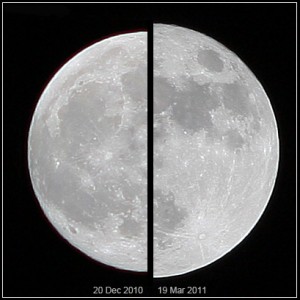The Biggest Supermoon in Years is Coming Saturday Night
The moon’s closest approach to earth will coincide with a perfectly full moon
/https://tf-cmsv2-smithsonianmag-media.s3.amazonaws.com/filer/Supermoon_header.jpg)
This Saturday evening, take a look at the night sky and you might see something special. The moon will make its largest, most stunning appearance of the year—an event known to scientists as “the perigee-syzygy of the Earth-Moon-Sun system” and to the popular skywatching public simply as the “supermoon.” As one of the most spectacular supermoons in years, the moon will appear 14 percent bigger and 30 percent brighter than when it is on the far side of its orbit.
Why does the moon sometimes appear larger, and sometimes smaller? The answer lies in the fact that its orbit around Earth is elliptical, so its distance from us varies—it ranges from roughly 222,000 to 252,000 miles away each month. On Saturday, the moon will reach what is known as the perigee, coming as close as it ever does to the Earth, just 221,802 miles away. At the same time, it will be a full moon, with the entirety of its Earth-facing surface illuminated by the light of the sun.
This supermoon will appear especially large because the exact moment of perigee will neatly coincide with the appearance of a perfectly full moon. The full moon will occur at 11:34 p.m. EST, and the perigee will occur at 11:35. During last year’s supermoon on March 19, 2011, for comparison, the perigee and full moon were 50 minutes apart.

A comparison of last year's March supermoon (right) with an average moon from December 2010. Photo by Wikimedia Commons user Marcoaliaslama
“The timing is almost perfect,” says NASA, according to the Washington Post. AccuWeather’s astronomy blogger Daniel Vogler notes that a look through recent data reveals no more closely-timed (and therefore bigger) supermoons.
Apart from providing a sight to behold in the night sky, the moon’s perigee also has a tangible effect on Earth: It causes higher than normal tides. Because tides are driven by the moon’s gravitational effects, a closer moon means that the oceans will be pulled more than usual towards the satellite. In most places, this will mean a tide that is an inch or so higher than usual, but geographical factors can multiply the effect up to around six inches.
There has long been speculation that the moon’s gravitational effect during its perigee could be the cause of natural disasters, including earthquakes and volcanic activity. In particular, many suggested this link following the earthquake and subsequent tsunami off the coast of Japan in March of 2011. However, the devastating quake occurred over a week before the supermoon, and studies have shown no strong evidence for increased frequency of high-intensity seismic activity during the moon’s perigee.
There are more concrete examples, though, in which supermoons may cause problems. In particular, flooding during storms may be made more severe because of the higher tides. In 1962, the coincidental arrival of a powerful storm with the moon’s perigee inundated the entire Atlantic coast of Cape Cod, causing 40 deaths and $500 million in property damage.
On Saturday, assuming no damaging storms or floods are at your doorstep, just hope for a clear night and take a look outside. The moon will appear larger and brighter than usual all night, but for the most striking views, try to catch it just after it rises above the horizon, when an optical illusion causes it to look larger than it really is, and viewing it through the gases of the earth’s atmosphere can cause the moon to appear yellow, orange or red in color.
/https://tf-cmsv2-smithsonianmag-media.s3.amazonaws.com/accounts/headshot/joseph-stromberg-240.jpg)
/https://tf-cmsv2-smithsonianmag-media.s3.amazonaws.com/accounts/headshot/joseph-stromberg-240.jpg)